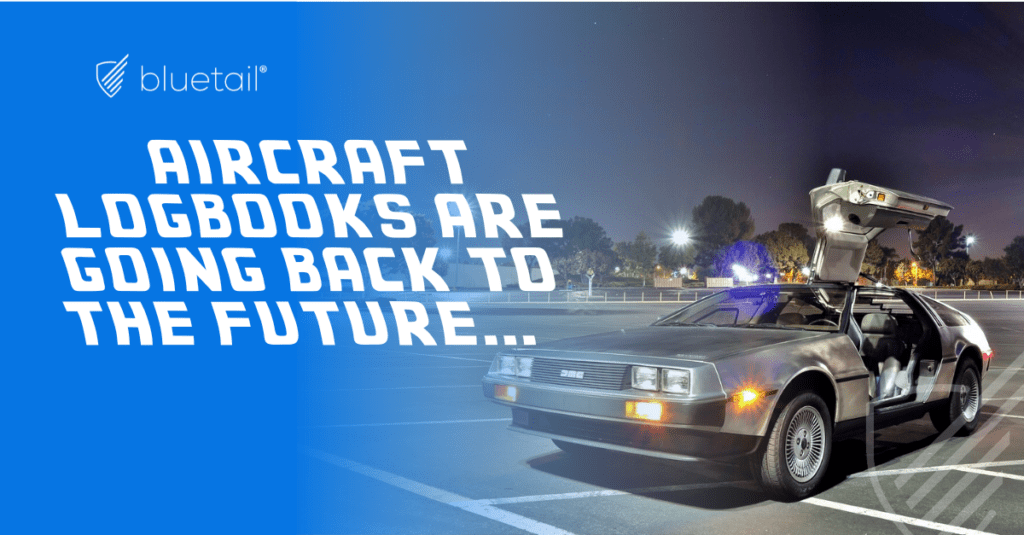
Let’s go on a time-travel adventure. I’ve set the date on my DeLorean Time Machine retrofitted with an aerospace “flux capacitor” to early 1992. I agree with ‘Ol Doc Brown, “If you’re gonna’ build a time machine out of a flying car, why not do it with some style.” The location? Well, let’s just say it’s the hangar of a flight department owned by a major U.S. corporation.
Ah, we’re in luck; the DOM is tasking their lead A&P, a guy named M. McFly (appropriate name for an A&P), with searching through the operations and maintenance logs of one of their Gulfstream GIVs. The poor A&P doesn’t look happy.
He already knows he’s faced with a long and tedious job ahead. He’s got to go to their “records storage” closet and begin the painstaking process of going through page after page after page of paper logbooks.
And because this kind of redundancy is so mind-numbing, he sometimes has to go through each Banker’s Box and its contents multiple times to verify that none of the critical information he required was overlooked—no fun considering that it’s January and that part of the hangar isn’t heated.
Anyway, at that same time, not far away at the University of Illinois, a group of graduate students were taking the first steps to develop a sophisticated Internet browser they called Mosaic (later renamed Netscape), which would provide a user-friendly way to search the Worldwide Web.
Mosaic allowed users to see words and pictures on the same page for the first time and to navigate using scrollbars and clickable links. The user-friendly Internet was born.
According to the folks at the History Channel (you don’t actually think I memorized any of this), not long after Mosaic went live, and through no purposeful decision-making on its own, the U.S. Congress decided that the Web could be used for commercial purposes.
And the rest, as they say, is history. Companies of all kinds hurried to set up their own websites, and ecommerce entrepreneurs began to use the Internet to sell goods directly to customers. Yes, there was the great Dot.Com collapse years later, but that’s another story.
You’ve got your chocolate in my peanut butter…
Anyway, way back then, it was quite a stretch to get your mind around the impact that the Internet would have on our future day-to-day jobs. But it wasn’t long before two great technologies came together, digitized information and the Internet.
Today, thanks to the devices in our pockets, we can Google, Bing, DuckDuckGo, or whatever service we like to instantly search, find, and share pretty much any bit of mankind’s accumulated knowledge.
By the way, if Biff had even the slightest inkling of what the Internet would become, he would have stolen an iPad and not the 2015 Sports Almanac. Sorry, I digress…
1.21 Gigawatts of records search power at your fingertips.
So, what does all this have to do with our A&P’s time-consuming (wasting) search through the GIV’s paper-based maintenance history? Plenty.
Back in 1992, there were no options for retrieving vital information other than searching through paper records–Bluetail didn’t exist. However, if faced with the same task today, with Bluetail’s modern technology platform – the future is here. If the owner had already had the aircraft’s back-to-birth operational and maintenance logbooks professionally scanned and stored on Bluetail’s cloud-based network, access to all of that information would be just a quick and easy search away.
A few keystrokes into the Bluetail search box, and everything about that aircraft’s history is at his fingertips. All of it 100% accurate (at least as far as the books go) and securely sharable with anyone with access to the Internet.
So the choice is yours; You can search logs like it’s 1992, or you can visit the future. Sign-up for a demo at www.bluetail.aero/free-demo and learn how simple, fast, and affordable it is to bring your aircraft’s maintenance practices into the 21st century.